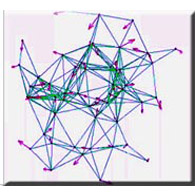The Need for this Institute
"The increasing complexity and interconnectedness of energy,
telecommunications, transportation, and financial infrastructures pose new challenges for secure, reliable management
and operation.1"
"Complex interactive networks are omnipresent and critical to economic and social well-being.1"
[1] M. Amin, "National Infrastructures as Complex Interactive Networks", Chapter 14 in Automation, Control,
and Complexity: An Integrated Approach, T. Samad and J. Weyrauch, Eds. (John Wiley and Sons, NY, 2000).
Why the University of New Mexico
- The University of New Mexico has a critical mass of creative and talented faculty and research staff that have been working on many aspects of these problems with their students for over a decade.
- The University of New Mexico is unique in that, it not only has faculty and research staff that cover the breadth of research in complex interactive networks, but it also has faculty and research staff that possess depth in research into the modeling and control of networks, and several specific threats to networks.
- The University of New Mexico is located in the hub of intense research activities in this field, with Los Alamos National Laboratory, Sandia National Laboratories, and the Air Force Research Laboratory at its doorstep.
- The University of New Mexico has formed the Institute for Infrastructure Surety in order to pool its talent and resources to work on this problem that is important to the State of New Mexico, as well as the Nation.
The Complex Nature of this
Multidisciplinary Problem
We view infrastructure surety as involving three layers:
- At the lowest layer, we consider specific physical threats to individual assets that might be stationary (such as a power plant that is part of a larger electric grid) or might be mobile (robotic sensors).
- At the middle layer, we consider communication and control within a network.
- At the highest layer, we consider more complex interactions, such as networks within networks. It could also involve the effects of social networks as well.
 Our Vision for the Institute
Our Vision for the Institute
The Institute was founded in the Summer 2004 by faculty in The University of
New Mexico Department's of Electrical & Computer Engineering, Computer Science, Mechanical Engineering, Civil Engineering,
and Mathematics & Statistics who decided to pool their talents and resources to address a shared concern: threats to the civilian
infrastructure and their mitigation. The faculty members of the Institute can be found here.
What Motivated us to Launch this Institute?
Although we have been working on various aspects of this problem across the School
of Engineering and with colleagues in Arts & Sciences, the awarding of the DTRA University Strategic Partnership Program has provided the impetus to found this Institute.
The Lowest Layer: Electromagnetic Attack -
Existing University Programs in the U.S.

Institute Unique Focus
| GOALS |
TOOLS |
RESULTS |
|
- Study Specific Physical Threats to the Civilian Infrastructure
- Assess Vulnerability to Cascading Failure
- Mitigate Threats
|
 |
 |
Sponsoring Agencies & Collaborating Organizations (to-date):
The following agencies are currently funding the Institute's Research
efforts:
More information can be found in this presentation.
|








